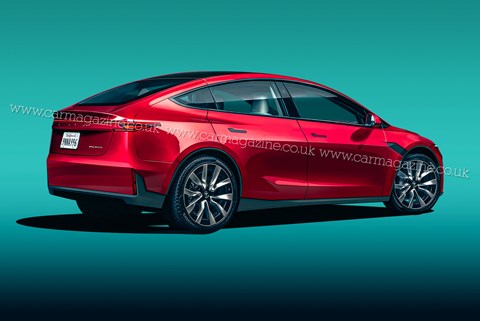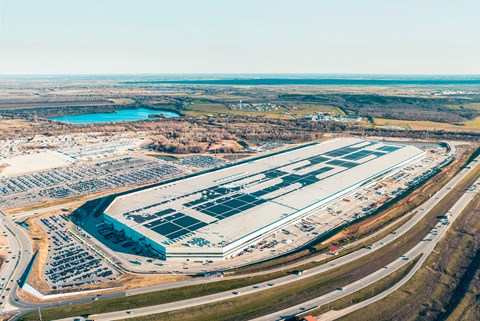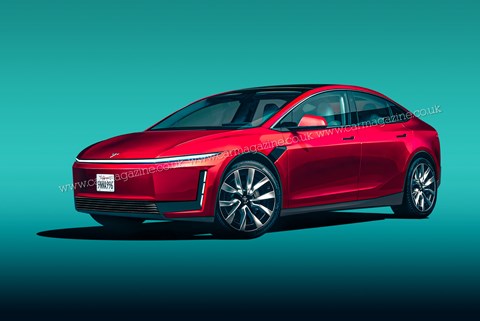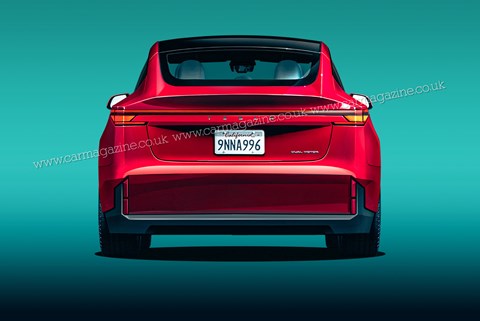► CAR’s debrief on Tesla Model 2 smaller EV
► Will reduce the entry price into Tesla life
► This time, Tesla’s had to think different
Tesla has always been clear – making cars is, for Musk’s marque, more a crusade than a commercial enterprise. Its Fremont plant has a display that perfectly sums up its mission statement about transitioning the world to sustainable transport: a 20th-century petrol pump next to a sleek 21st-century Tesla Supercharger, echoing the classic illustration depicting the evolution of primate to homo sapiens. You must go back here to understand the origins of the Tesla Model 2.
Lose sight of the mission statement and nothing much Tesla does makes sense. Back in 2016 it could have sat back on the Model S and Model X and remained a niche, premium player. But no. Along came the Model 3, orders sky-rocketed and Tesla was wracked with growing pains as it evolved to cope. Its fourth car, the Model Y, has proved even more popular. But despite recent price cuts the most affordable Tesla remains a £40k proposition. To complete the job Tesla needs a £25k car, dubbed the Model 2. It promises to be nothing less than the battery-electric equivalent of the Ford Model T.
CEO Elon Musk has described the new car as ‘our next-generation low-class vehicle’, and for ‘low-class’ read financially accessible. A silhouette teaser shown at the shareholder meeting last May hinted at a smaller Model Y, designed for slipperiness and ease of manufacture, rather than a WTF head-turner like the Cybertruck. Which is a relief.
As with the Model 3 and Model Y twins, there are likely two cars in the works – Musk told shareholders as much last May. Both will use a new architecture, codenamed NV9X, and further versions are expected, although Musk has publicly attacked established manufacturers for building ‘variants for the sake of variants’, so those hanging on for, say, an estate will likely be disappointed.
Tesla needs two body styles because it needs international sales. Larger models have a broad appeal globally, but the big three markets diverge when it comes to smaller cars. Hatchbacks will sell in Europe, but not really in the US or China. Similarly small saloons are niche in Europe but fine in China.
Together, Tesla is targeting annual sales of five million units, up from 1.81 million total in 2023 (1.74 million of which were Model Y/3). Musk has goals of ousting the Toyota Corolla or VW Golf globally.
 Tesla’s upcoming new Model 2 electric car, illustrated for CAR by LARSONdesign
Tesla’s upcoming new Model 2 electric car, illustrated for CAR by LARSONdesign
In February Ford CEO Jim Farley called the upcoming smaller Tesla ‘the ultimate competition’. Before fulfilling that wildly ambitious promise, Tesla has to perfect the assembly process. Because once again the company is throwing its innovation behind the production of the car, rather than reinventing the elements that the consumer will engage with.
‘This is a revolutionary manufacturing system; far more advanced than any other automotive manufacturing system in the world by a significant margin,’ Musk boasted to analysts on the company’s earnings call in January.
What Tesla does best is also what the Chinese do well and that’s build EVs cheaper. This allows both disrupters to sell at lower prices and grab market share from the established car makers.
Tesla has been relentless at driving down the cost of Model 3 and Model Y, some of which it gave back in price cuts with the rest feeding profit margins. But it needed a step change to get the new Model 2 down to $25k, the price that Musk quoted back in 2020. ‘We are approaching the limits within our current platforms,’ chief financial officer Vaibhav Taneja said on the January call.
This story led the April 2024 issue of CAR. Want faster and more in-depth access to CAR’s print and digital issues? Sign up here to read more with a free trial
Tesla is targeting a 50 per cent cost reduction in building the next-generation vehicle. The big innovation is to reinvent Henry Ford’s 111-year-old production line and move to what Tesla calls ‘unboxing’. So instead of the car taking shape slowly from initial metal stamping to body shop to paint shop and then final assembly – ‘Most of the time we’re doing nothing to it,’ head of vehicle engineering Lars Moravy said – Tesla wants to reorganise the factory to sub-assemble related parts.
For example the rear ‘megacast’ platform will be kitted out with wheels, seats and rear drive unit, while the front seats and centre console will be fitted on to the battery pack. All the pre-assembled parts will then be fitted together in one final burst of efficiency.
Essentially, fewer workers will operate more cost-effectively, allowing Tesla to reduce the manufacturing footprint by 40 per cent. Initially Tesla announced the car would be built in its planned new plant in Mexico, but has since said it’ll be first produced in Austin, Texas next to the Cybertruck.

Musk said ‘Giga Texas’ was chosen ‘because we really need the engineers to be living on the line’ in the initial phase, and it’s easier there than elsewhere, presumably while also imagining what the powerful German unions would say to that in Berlin. A third production site is being planned – possibly in Berlin, given the model’s importance to Europe.
Ramp-up will be slow, Musk warned in January, reminding everyone again about the Model 3’s ‘production hell’. ‘It always starts off real slow, and then it grows exponentially,’ he said. Model 3 entered production in 2017, but it wasn’t until 2019 that the car finally arrived in the UK. It could be 2027 then by the time the next-gen car arrives here, by which time all manner of new rivals will be hoping to thwart Tesla.
Cybertruck is Tesla’s newest model and there will be some carry-over of new technology, specifically the 48-volt electrical architecture, replacing 12 volts now. The advantage is a reduction in expensive copper, but higher ‘ethernet-level’ speed of communications between electronic parts, Musk said.
Tesla has been at the forefront of creating the ‘software-defined car’ in which fewer, more powerful computers process more data in a faster time than linking up dozens of smaller ECUs. This so-called ‘centralised compute’ system is much easier to update over the air as well, quickly adding new digital features to the large central screen.
 Tesla’s upcoming new Model 2 electric car, illustrated for CAR by LARSONdesign
Tesla’s upcoming new Model 2 electric car, illustrated for CAR by LARSONdesign
Another carryover from Cybertruck could be drive-by-wire to eliminate the steering column and make sense of the yoke wheel by varying the ratio, but there’s a cost attached that Musk may not be prepared to pay for his entry model.
Tesla’s ‘Full Self-Driving’ suite (actually hands-on, eyes-on Level 2 autonomous, at least in Europe) will be part of the package but, given the company has removed more sensors than it has added, it remains to be seen if the Model 2 would even gain Level 2+ hands-off, eyes-on ability, let alone full autonomy.
Tesla champions its data learning over sensor input to solve the ever problematic self-driving ‘edge cases’ (a swan on the road, for example), but it’s unlikely regulators will see eye to eye on that.
Range will be key. The battery chemistry itself is not within Tesla’s gift to improve, leaving that instead to suppliers including China’s CATL and BYD (for the cheaper LFP chemistry), as well as South Korea’s LG Chem and its long-time collaborator from Japan, Panasonic.
However, Tesla is planning to use the larger 4680 cylindrical battery (46mm diameter, 80mm high) that the company has been slowly and painfully developing to replace the smaller 2170 battery. Tesla claims a range bump from the increased energy density, but the advantages are also in manufacturing efficiency in its cell plants with the aim of reducing price. Tesla claims the battery has 15 parts involving 21 manufacturing processes, against 17 parts and 33 processes for the smaller 2170 cell.
The electric drive unit (motor, inverter, gearbox) is another part scrutinised by Tesla’s accountants, both in its design and construction. We’re told it’ll have a 75 per cent reduction in silicon carbide, a material that increases range and efficiency but also cost. The next-gen permanent-magnet motor has no rare earths, Tesla also claimed at its investor day. In all, Tesla reckons it has cut the cost of its drive unit to around $1000.
 Tesla’s upcoming new Model 2 electric car, illustrated for CAR by LARSONdesign
Tesla’s upcoming new Model 2 electric car, illustrated for CAR by LARSONdesign
How much Tesla will reduce battery size to get to an attractive price point price of, say, under £30,000 in the UK we don’t know – but bet on one version at least reaching over 300 miles on the official range test. Bet too on an all-wheel-drive option, given how many of Europe’s wealthier car buyers are in the (occasional) snow belt.
It’s no exaggeration to say Tesla has been leading up to this car its whole existence, right from when Lotus built the first production Roadster for Tesla back in 2008. The journey since has been focused on ruthlessly driving costs out of the electric car to a point, probably three years from now, when this car falls into the budget of a Golf or Qashqai buyer, and they switch over. That prospect should make Volkswagen, Toyota and the rest extremely nervous.
This story led the April 2024 issue of CAR. Want faster and more in-depth access to CAR’s print and digital issues? Sign up here to read more with a free trial